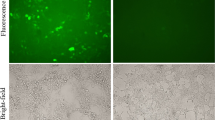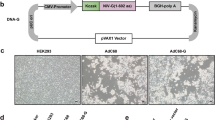Abstract
DNA vaccines expressing the E6 or E7 oncoproteins of human papilloma virus type 16 (HPV-16) in either their wild-type form or fused to sequences that affect intracellular trafficking were tested for induction of protective immunity against tumor cell challenge in two models based on BALB/c and C57Bl/6 mice. The DNA vaccines to E7 gave uniformly disappointing results, while the DNA vaccine that expressed E6 linked to a viral leader sequence protected BALB/c mice against tumor cell challenge given before or after vaccination. The efficacy of this vaccine could be enhanced by a DNA vector prime/viral vector boost regimen. In contrast, priming of mice with the DNA vaccines to E7 reduced the efficacy of a viral vector expressing the same antigen.
This is a preview of subscription content, access via your institution
Access options
Subscribe to this journal
Receive 12 print issues and online access
$259.00 per year
only $21.58 per issue
Buy this article
- Purchase on Springer Link
- Instant access to full article PDF
Prices may be subject to local taxes which are calculated during checkout




Similar content being viewed by others
References
Stone KM, Karem KL, Sternberg MR, et al. Seroprevalence of human papillomavirus type 16 infection in the United States. J Infect Dis. 2002;186:1396–1402.
zur Hausen H . Papillomavirus infections—a major cause of human cancers. Biochim Biophys Acta. 1996;1288:F55–F78.
Munger K, Howley PM . Human papillomavirus immortalization and transformation functions. Virus Res. 2002;89:213–228.
Borysiewicz LK, Fiander A, Nimako M, et al. A recombinant vaccinia virus encoding human papillomavirus types 16 and 18, E6 and E7 proteins as immunotherapy for cervical cancer. Lancet. 1996;347:1523–1527.
Lin KY, Guarnieri FG, Staveley-O'Carroll KF, et al. Treatment of established tumors with a novel vaccine that enhances major histocompatibility class II presentation of tumor antigen. Cancer Res. 1996;56:21–26.
Feltkamp MC, Smits HL, Vierboom MP, et al. Vaccination with cytotoxic T lymphocyte epitope-containing peptide protects against a tumor induced by human papillomavirus type 16-transformed cells. Eur J Immunol. 1993;23:2242–2249.
He Z, Wlazlo AP, Kowalczyk DW, et al. Viral recombinant vaccines to the E6 and E7 antigens of HPV-16. Virology. 2000;270:146–161.
Smahel M, Sima P, Ludvikova V, et al. Modified HPV16 E7 genes as DNA vaccine against E7-containing oncogenic cells. Virology. 2001;281:231–238.
Osen W, Peiler T, Ohlschlager P, et al. A DNA vaccine based on a shuffled E7 oncogene of the human papillomavirus type 16 (HPV 16) induces E7-specific cytotoxic T-cells but lacks transforming activity. Vaccine. 2001;19:4276–4286.
Daemen T, Pries F, Bungener L, et al. Genetic immunization against cervical carcinoma: induction of cytotoxic T lymphocyte activity with a recombinant alphavirus vector expressing human papillomavirus type 16 E6 and E7. Gene Therapy. 2000;7:1859–1866.
Liu DW, Tsao YP, Hsieh CH, et al. Induction of CD8 T-cells by vaccination with recombinant adenovirus expressing human papillomavirus type 16 E5 gene reduces tumor growth. J Virol. 2000;74:9083–9089.
Wu TC, Guarnieri FG, Staveley-O'Carroll KF, et al. Engineering an intracellular pathway for major histocompatibility complex class II presentation of antigens. Proc Natl Acad Sci USA. 1995;92:11671–11675.
Rodriguez F, Zhang J, Whitton JL . DNA immunization: ubiquitination of a viral protein enhances cytotoxic T-lymphocyte induction and antiviral protection but abrogates antibody induction. J Virol. 1997;71:8497–8503.
Pasquini S, Deng H, Reddy ST, et al. The effect of CpG sequences on the B cell response to a viral glycoprotein encoded by a plasmid vector. Gene Therapy. 1999;6:1448–1455.
Wlazlo AP, Giles-Davis W, Clements A, et al. Generation and characterization of monoclonal antibodies against the E6 and E7 oncoproteins of HPV. Hybridoma. 2001;20:257–263.
Deng H, Kowalczyk D, O InSug, et al. A modified DNA vaccine to p53 induces protective immunity to challenge with a chemically induced sarcoma cell line. Cell Immunol. 2002;215:20–31.
Kowalczyk DW, Wlazlo AP, Shane S, et al. Vaccine regimen for prevention of sexually transmitted infections with human papillomavirus type 16. Vaccine. 2001;19:3583–3590.
Fu ZF, Dietzschold B, Schumacher CL, et al. Rabies virus nucleoprotein expressed in and purified from insecT-cells is efficacious as a vaccine. Proc Natl Acad Sci USA. 1991;88:2001–2005.
Blaszczyk-Thurin M, Ertl IO, Ertl HC . An experimental vaccine expressing wild-type p53 induces protective immunity against glioblastoma cells with high levels of endogenous p53. Scand J Immunol. 2002;56:361–375.
Kowalczyk DW, Wlazlo AP, Blaszczyk-Thurin M, et al. A method that allows easy characterization of tumor-infiltrating lymphocytes. J Immunol Methods. 2001;253:163–175.
Xiang Z, Ertl HC . Manipulation of the immune response to a plasmid-encoded viral antigen by coinoculation with plasmids expressing cytokines. Immunity. 1995;2:129–135.
Ramshaw IA, Ramsay AJ . The prime-boost strategy: exciting prospects for improved vaccination. Immunol Today. 2000;21:163–165.
Yang ZY, Wyatt LS, Kong WP, et al. Overcoming immunity to a viral vaccine by DNA priming before vector boosting. J Virol. 2003;77:799–803.
Koutsky LA, Ault KA, Wheeler CM, et al. A controlled trial of a human papillomavirus type 16 vaccine. N Engl J Med. 2002;347:1645–1651.
Krieg AM . CpG motifs in bacterial DNA and their immune effects. Annu Rev Immunol. 2002;20:709–760.
Katz DH, Hamaoka T, Dorf ME, et al. Cell interactions between histoincompatible T and B lymphocytes. IV. Involvement of the immune response (Ir) gene in the control of lymphocyte interactions in responses controlled by the gene. . J Exp Med. 1973;138:734–739.
Vierboom MP, Feltkamp MC, Neisig A, et al. Peptide vaccination with an anchor-replaced CTL epitope protects against human papillomavirus type 16-induced tumors expressing the wild-type epitope. J Immunother. 1998;21:399–408.
Schirmbeck R, Bohm W, Ando K, et al. Nucleic acid vaccination primes hepatitis B virus surface antigen-specific cytotoxic T lymphocytes in nonresponder mice. J Virol. 1995;69:5929–5934.
Xiang ZQ, Pasquini S, Ertl HC . Induction of genital immunity by DNA priming and intranasal booster immunization with a replication-defective adenoviral recombinant. J Immunol. 1999;162:6716–6723.
Ji H, Wang TL, Chen CH, et al. Targeting human papillomavirus type 16 E7 to the endosomal/lysosomal compartment enhances the antitumor immunity of DNA vaccines against murine human papillomavirus type 16 E7-expressing tumors. Hum Gene Therapy. 1999;10:2727–2740.
Reyes-Sandoval A, Ertl HC . DNA vaccines. Curr Mol Med. 2001;1:217–243.
Gunn GR, Zubair A, Peters C, et al. Two Listeria monocytogenes vaccine vectors that express different molecular forms of human papilloma virus-16 (HPV-16) E7 induce qualitatively different T-cell immunity that correlates with their ability to induce regression of established tumors immortalized by HPV-16. J Immunol. 2001;167:6471–6479.
O InSug, Blaszczyk-Thurin M, Shen CT, et al. A DNA vaccine expressing tyrosinase-related protein-2 induces T-cell-mediated protection against mouse glioblastoma. Cancer Gene Therapy. 2003;10:678–688.
Kotecha MT, Afghan RK, Vasilikopoulou E, et al. Enhanced tumour growth after DNA vaccination against human papillomavirus virus E7 oncoprotein: evidence for tumour-induced immune deviation. Vaccine. 2003;21:2506–2515.
Acknowledgements
This work was supported by grants from NCI and NIAID. Dr AP Wlazlo was a recipient of a fellowship from the Cancer Research Foundation of America and from NIH/NIAID. We thank the Commonwealth Universal Research Enhancement Program, Pennsylvania Department of Health.
Author information
Authors and Affiliations
Corresponding author
Rights and permissions
About this article
Cite this article
Wlazlo, A., Deng, H., Giles-Davis, W. et al. DNA vaccines against the human papillomavirus type 16 E6 or E7 oncoproteins. Cancer Gene Ther 11, 457–464 (2004). https://doi.org/10.1038/sj.cgt.7700723
Received:
Published:
Issue Date:
DOI: https://doi.org/10.1038/sj.cgt.7700723
Keywords
This article is cited by
-
A prime/boost strategy using DNA/fowlpox recombinants expressing the genetically attenuated E6 protein as a putative vaccine against HPV-16-associated cancers
Journal of Translational Medicine (2015)
-
Therapeutic HPV DNA vaccines
Immunologic Research (2010)
-
Equivalent stimulation of naive and memory CD8 T cells by DNA vaccination: a dendritic cell‐dependent process
Immunology & Cell Biology (2009)



